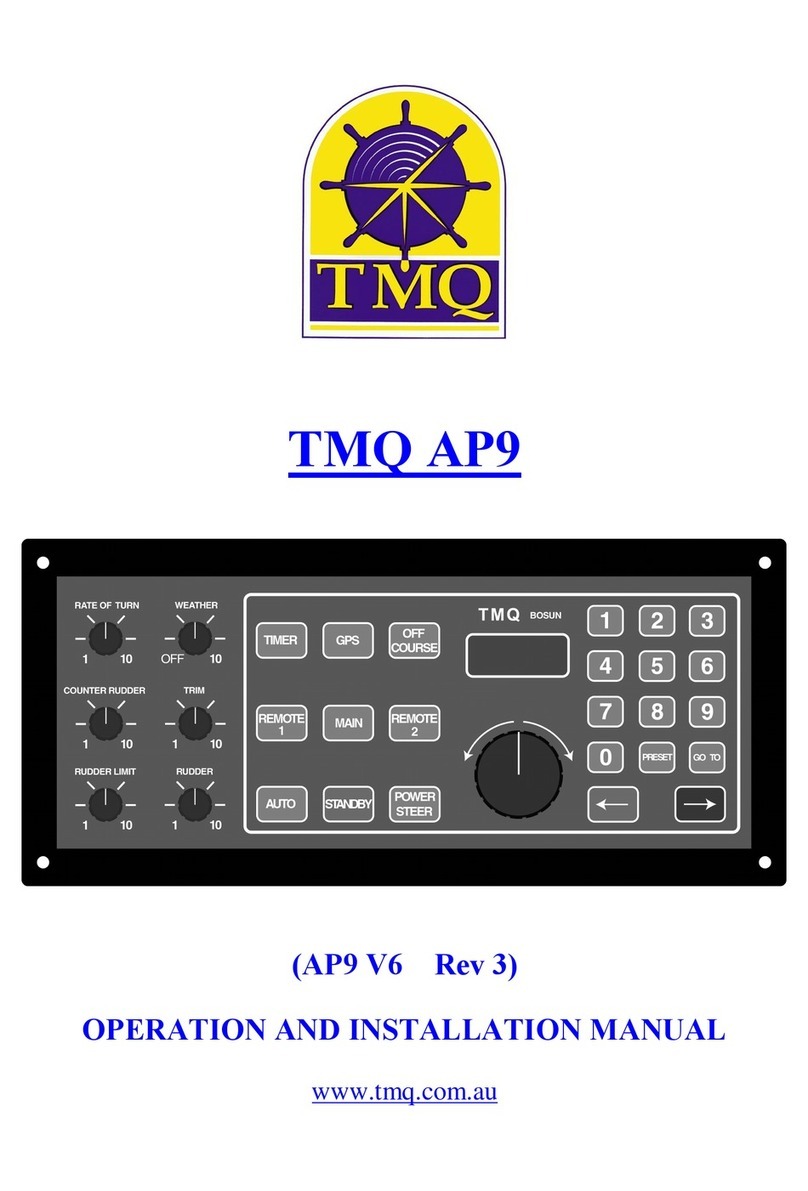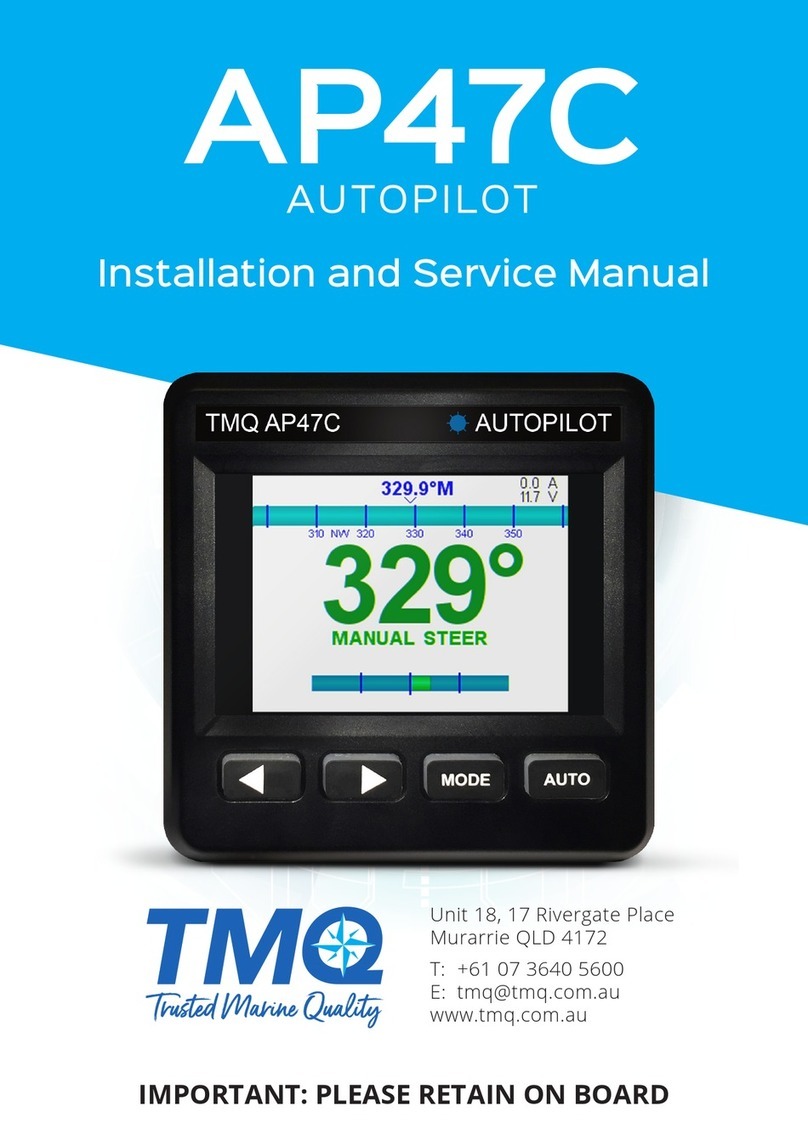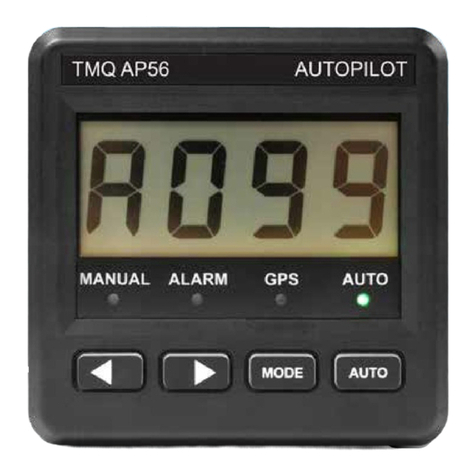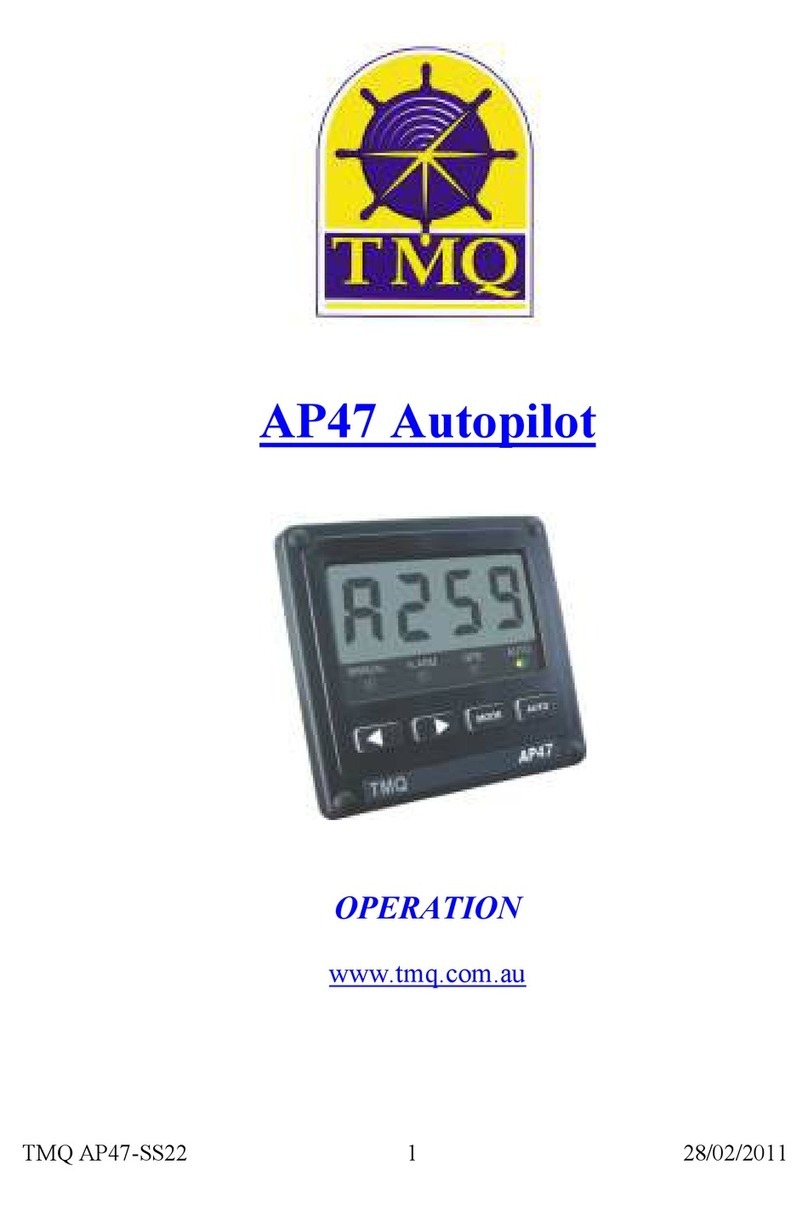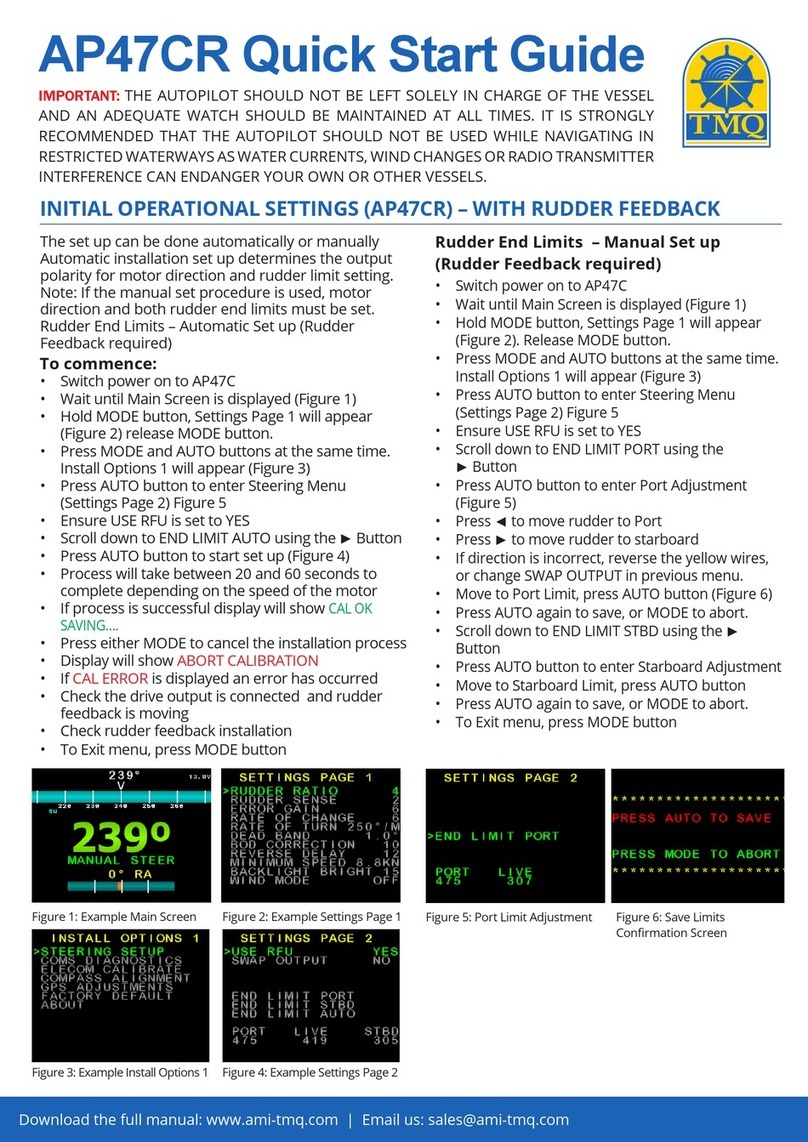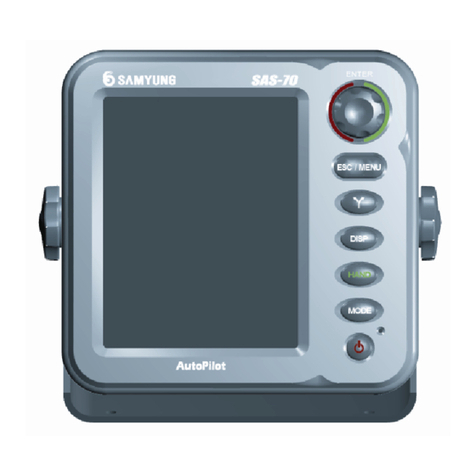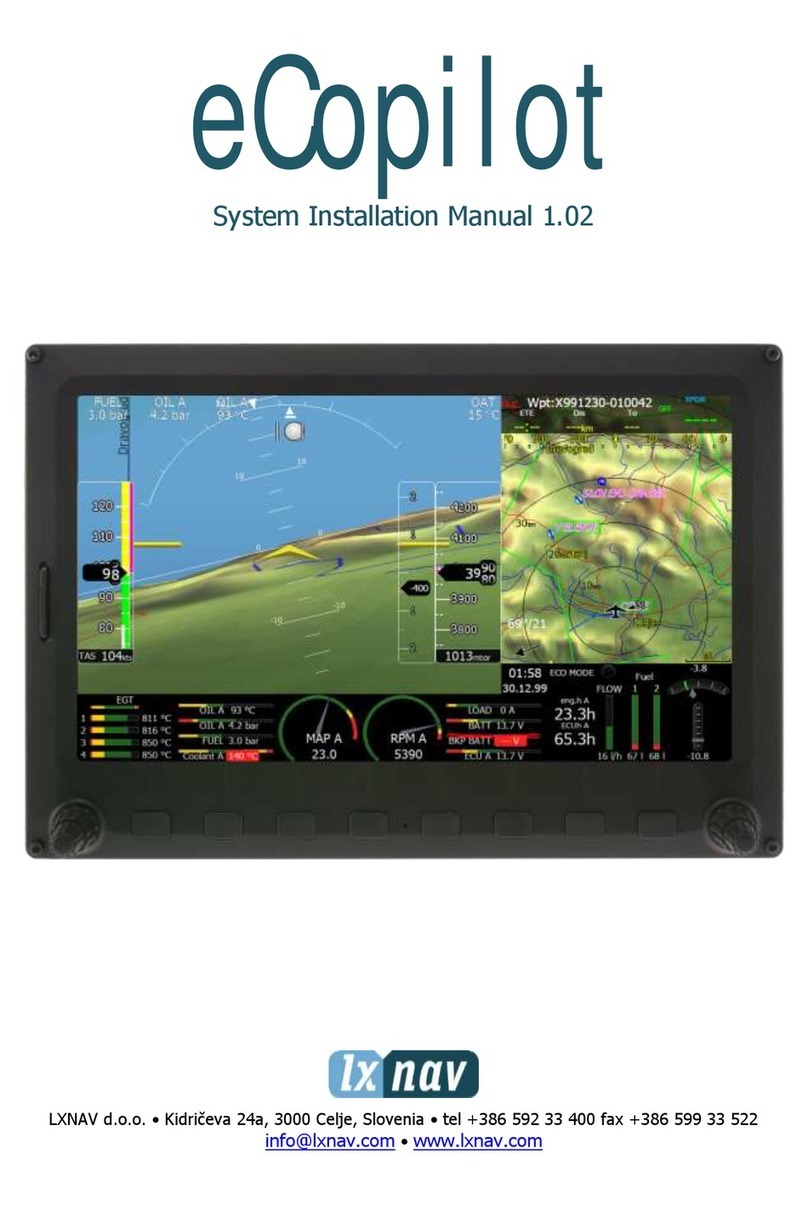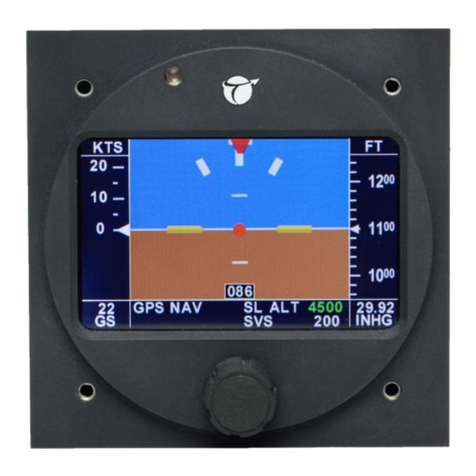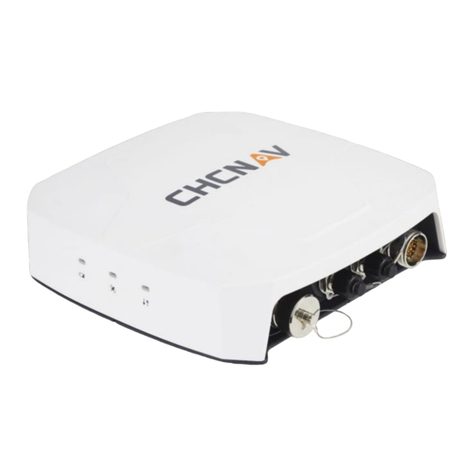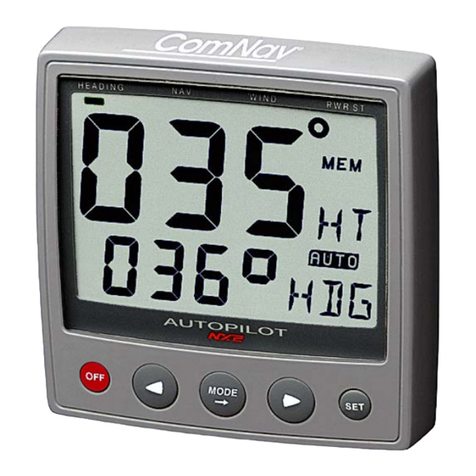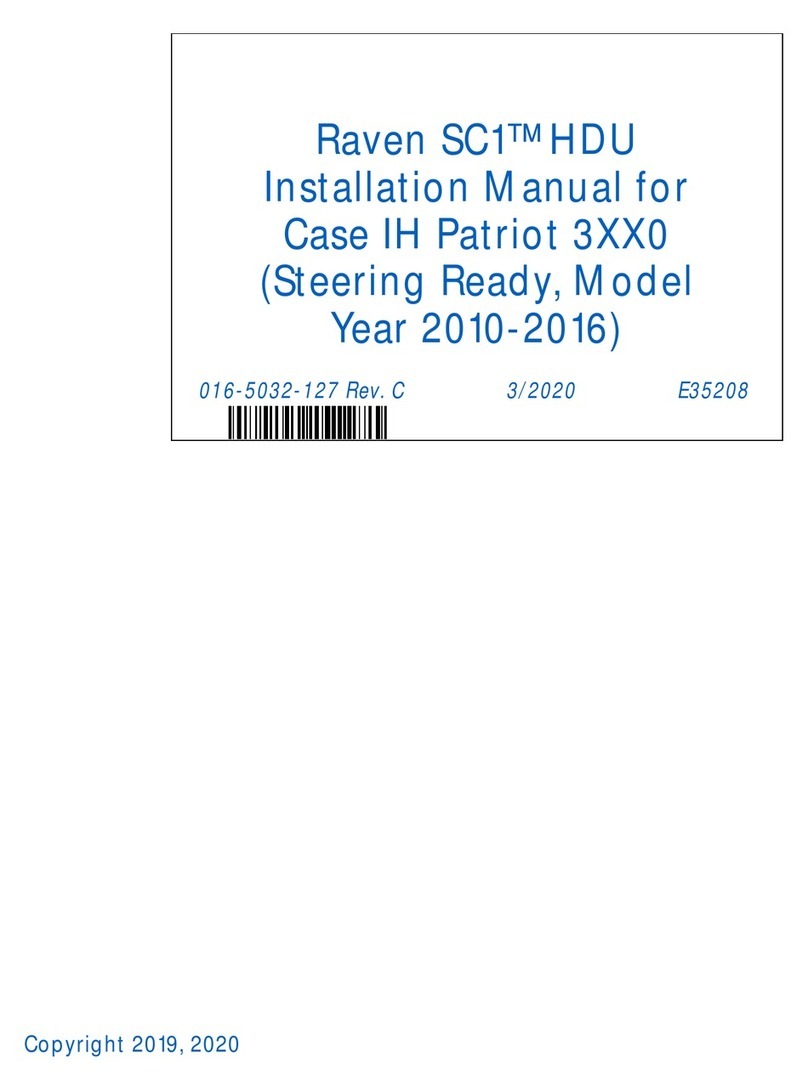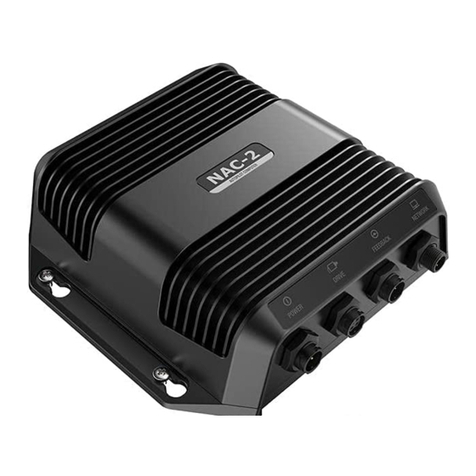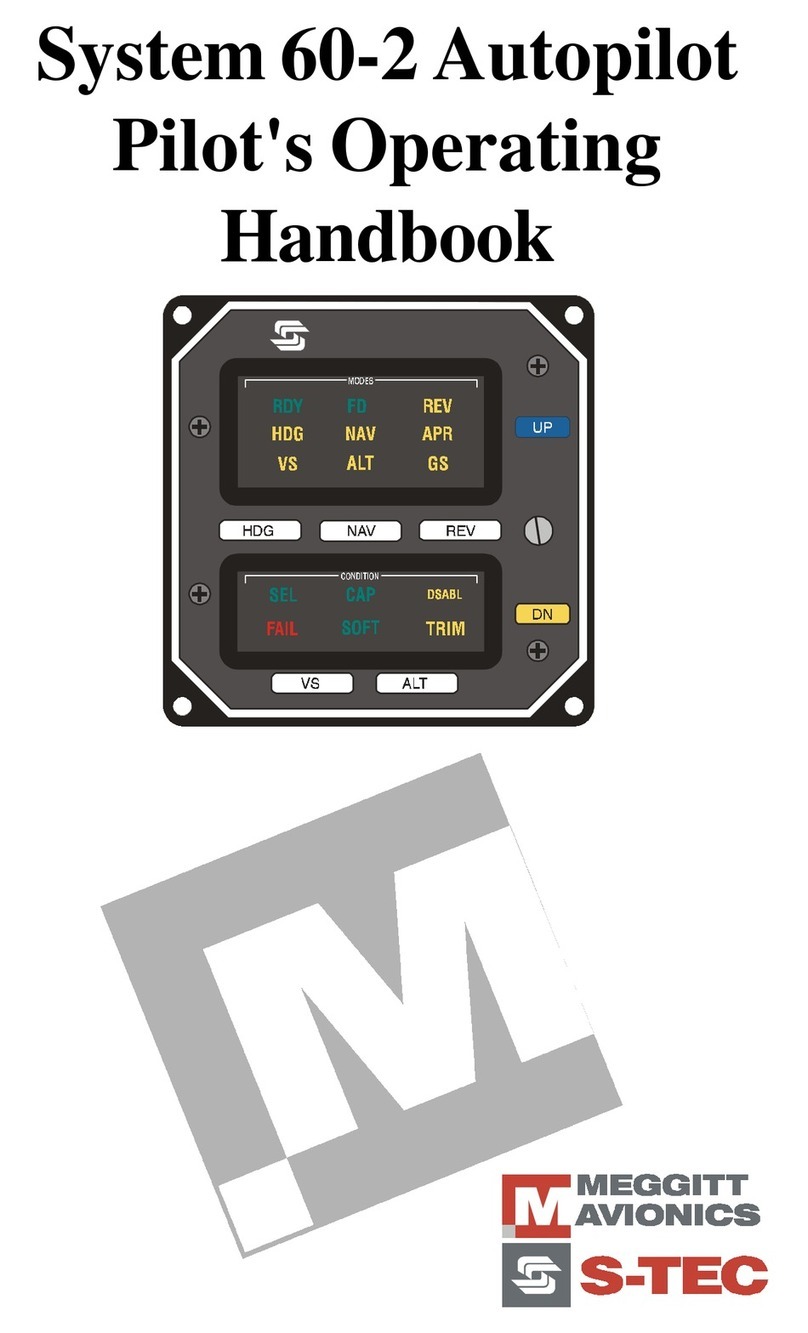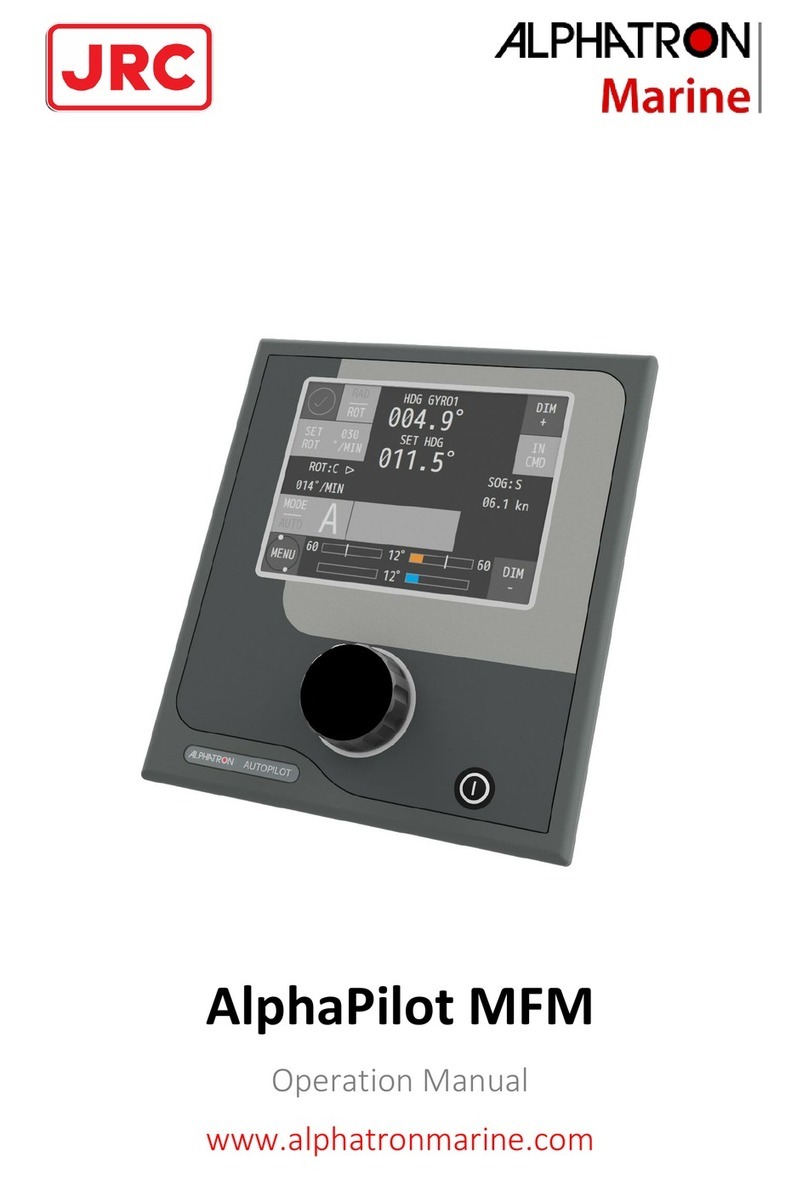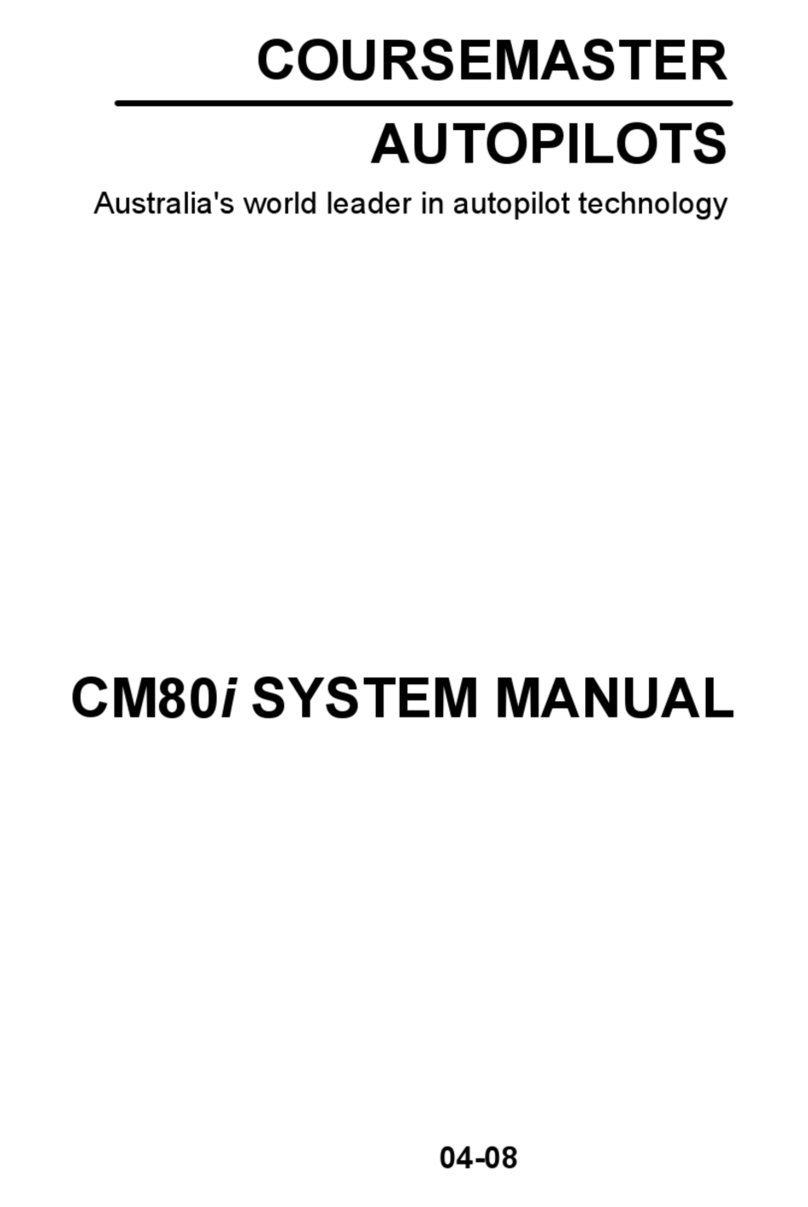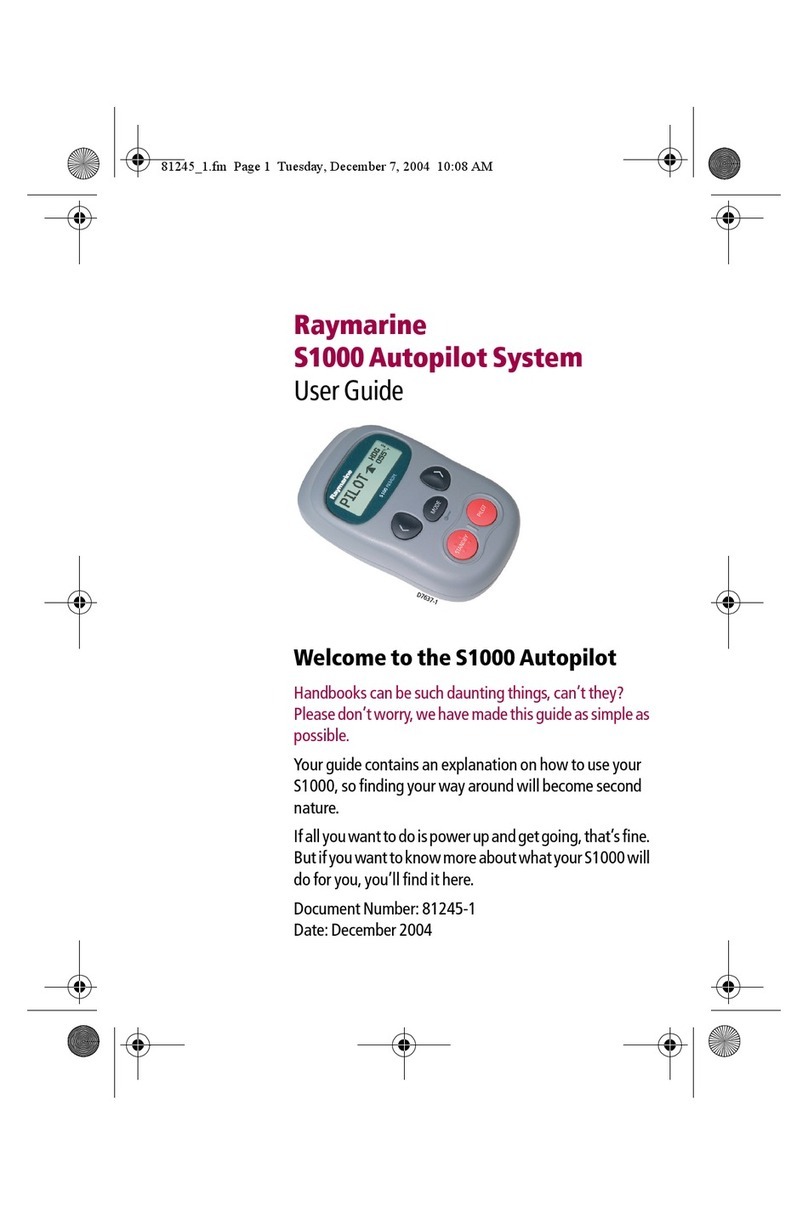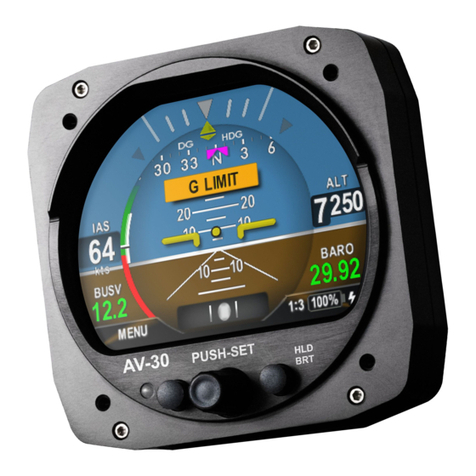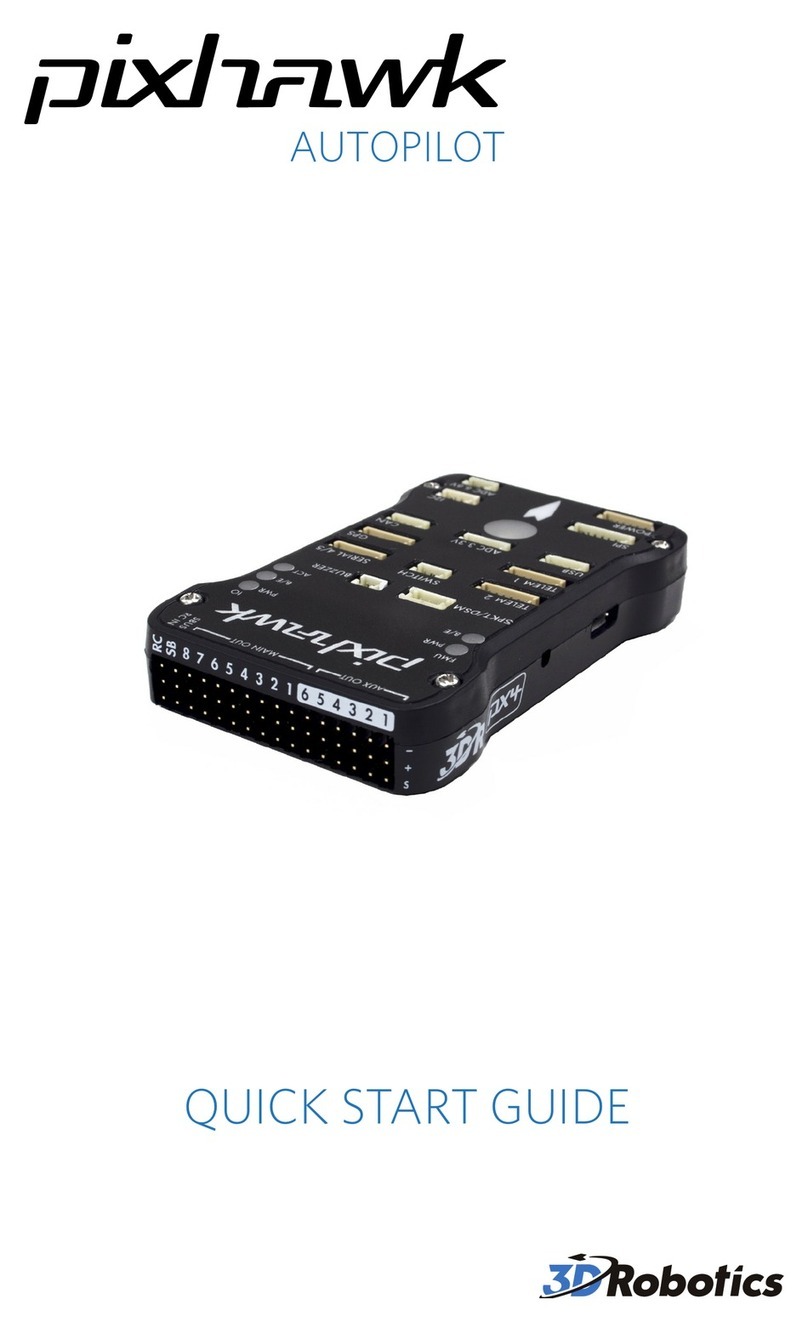TMQ AP4 Manual

IMPORTANT: PLEASE RETAIN ON BOARD
Installation and Service Manual
AP4
AUTOPILOT
Unit 18, 17 Rivergate Place
Murarrie QLD 4172
T: +61 07 3640 5600
www.tmq.com.au

(This page intentionally left blank)

Contents
Introduction 2
Warning 2
Overview 2
Autopilot Operation - Standard 3
Set (Standby) 4
Auto 4
Power Steering 4
GPS – Waypoint Steering 5
Watch Timer Mode 6
Commercial Boat Watch Timer 6
Autopilot Operation -
Remote Control 7
Hand Remote 7
Active Remote 8
Steering Lever &
Electric Helm Steering 10
Jog Switch Steering 10
Sensitivity & Rudder Adjustments 12
Alarms 13
Installation of Autopilot 14
List of Components 14
Installation of Main Control Unit 15
Installing a Compass Top Sensor 17
Installing a Magnetic
Sensor Unit (Fluxgate Compass) 17
Magnetic Sensor Unit &
Compass Top Sensor Interchange 18
Installation of Rudder Feedback 19
Installation of Remote Units 22
NMEA Connection 23
Heading Data Connections 24
External Alarm Installation 26
Wiring Connections –
AP4 Rear Panel 27
Examples -
Drive Connection Diagrams 28
General Information - Drive Units 29
Commissioning Checks 30
Post Installation Checks 30
Pre Sailing Dockside Tests 30
Sea Trials 31
Rudder Limits Setting 32
Compass Calibration 34
Calibrating TMQ Compass -
COMMAG 34
Calibrating TMQ Electronic
Compass - ELECOM 35
Resetting Compass to Factory
Calibration 35
AP4 Special Modes 36
Operating Without RFU 38
Adjusting the PID Control 38
Keeping the Heading 38
Following a Track (Waypoint) 39
Optional Extras 41
Declaration of Conformity 42
Warranty 43
Troubleshooting 44

2 of 45 TMQ AP4 | Revision Date: 01.07.2022 Version 10588
Introduction
WARNING
AUTOMATIC PILOTS ARE
DESIGNED TO BE A NAVIGATIONAL
AID AND SHOULD NEVER BE
LEFT SOLELY IN CHARGE OF THE
VESSEL. AN ADEQUATE WATCH
SHOULD BE MAINTAINED AT ALL
TIMES.
IT IS RECOMMENDED THAT THE
AUTOPILOT NOT BE USED WHILE
NAVIGATING IN RESTRICTED
WATERWAYS AS WATER
CURRENTS, WIND CHANGES
OR RADIO TRANSMITTER
INTERFERENCE MAY AFFECT
VESSEL COURSE SUFFICIENTLY
TO ENDANGER YOUR OWN OR
OTHER VESSELS.
Overview
The AP4 autopilot is a rugged &
reliable pilot for use on all sorts of
vessels, motor or sail, commercial or
pleasure. The front panel has large
control knobs for ease of use in all
sea conditions. It has various special
modes of operation to cater for all
dierent requirements.
An AP4 system comprises the
following essential components:
• Control Unit
• Compass
• Rudder Feedback Unit
• Rudder drive system
Optional Components:
• Hand or active remote
• Second remote control display
• Steering lever or electric helm
• Rudder angle indicator
• External alarm
This autopilot can control the
movement of the rudder through a
mechanical drive motor, reversing
hydraulic pump, solenoid valves on a
constant running pump or relays. The
motor outputs have been carefully
designed to work with a wide range of
motors - for more information, consult
your dealer or TMQ Electronics.
• The autopilot unit should be
installed out of direct sunlight and
protected from water and spray.
• The compass must be installed in
a place free of magnetic
interference, and connected to the
autopilot.
• The rudder feedback must be
attached to the rudder in such a
way that it can accurately measure
the position of the ships rudder and
is also connected to the autopilot.
Provision has been made for two
standard remotes, either hand remote
or steering lever. Alternatively one
active remote can be used. The
special remote mode of operation
may have to be adjusted for the
various control devices. Extra devices
may be connected via the internal
connection strip, for example, GPS
compass heading input.

3 of 45
TMQ AP4 | Revision Date: 01.07.2022 Version 10588
For more information on installation
of your AP4 autopilot, see the
Installation of Autopilot section of
this manual.
For more information on using your
AP4 autopilot, see the Autopilot
Operation section of this manual.
All control units operate on 12 or
24 volts DC. Electrical cables are
supplied for interconnection of
equipment. Hardware is supplied to
mount and couple the mechanical
drive unit into the steering system.
Hydraulic installation kits can be
supplied (optional at extra cost) if
the pipe size and brand of hydraulic
system is specied.
Autopilot Operation -
Standard
The following is a brief overview of
the capabilities of the AP4 autopilot.
Each is described in more detail later
in following pages.
• Set/Standby Mode
The digital display shows the
current magnetic heading.
The autopilot does not apply any
steering corrections.
• Auto Mode
The autopilot maintains your boat
on the selected magnetic course.
Course can be set or changed by
rotating the Course knob or from a
remote steering station.
• Power Steer
The rudder may be controlled by
the course knob on the main panel
or from a remote steering station.
• GPS Mode
When receiving information from a
GPS unit, the autopilot can steer
a vessel along a preset track to a
precise latitude and longitude.
• Watch Timer
A timer can be set from 1 to 120
minutes. When the time expires, an
alarm sounds. Uses include timing
of trawling runs or a reminder
to check for anchor drag at set
periods.
• Commercial Watch Timer
For vessels under survey. The
timer can be set to give a warning
alarm at a xed preset time and
provide an output control signal
for a loud external alarm 1 minute
after the internal alarm sounds.
Note: External alarm piezo siren
must be tted

4 of 45 TMQ AP4 | Revision Date: 01.07.2022 Version 10588
Set (Standby)
• MODE switch in SET position
• The AUTO light is o *
• The motor clutch is disengaged *
• No steering control output is
generated *
• The digital display shows the
vessels current magnetic course.
• Watch Alarm may be set (if
required)
• Hand remote or steering lever (if
installed) is ignored at rst turn on.
• Other special remote modes are
accessible (refer later)
* Apart from when in some of
the remote modes.
Possible alarm
• Watch timer alarm (if set)
Auto
Engaging Auto steering mode
• Rotate MODE switch to AUTO
• AUTO light is on
• Pilot is “locked on” to the course
showing on display
• Steering control is generated
• Rudder can be driven to the limit
set position
• Waypoint steering can be activated
(if GPS available)
• Watch alarm can be activated.
Disengaging the Autopilot
• Rotate the MODE switch to the
SET position
• AUTO light is o
• Steering control is deactivated.
• Display shows boat heading
• Boat under manual steering control
(helm)
Course Adjustment in AUTO
• Rotating the large course control
knob (each "click" is 1º course
change)
• Display shows course to steer after
adjustment
• Each full rotation of course change
knob gives 24º
Possible alarms
• O course (more than 45º)
• Watch timer (if set)
• FUS Indicated advises the internal
fuse is open
Power Steering
Engaging Power Steering Mode
• Rotate the MODE switch to the
PWR position.
• AUTO light is on
• Display shows boat heading
• Boat is steered by rotating the
COURSE knob
• Change course by rotating knob
Note: The maximum amount of
rudder which can be applied is
controlled by Rudder Limit setting
(see installation section).
For information on Power Steering
with a remote unit (eg: steering levers)
see the section on remote units.
Possible alarm
• Watch timer (if set)
• FUS Indicated advises the internal
fuses is open

5 of 45
TMQ AP4 | Revision Date: 01.07.2022 Version 10588
GPS – Waypoint Steering
Autopilot must be interfaced to a GPS
Plotter generating NMEA 0183 data
output. A route has to be selected on
the GPS (refer GPS manual).
Note: Before using this functionality,
make sure the auto mode is
working properly and adjusting
its variables if necessary. How to
adjust the auto mode is explained
in the section “Sensitivity & Rudder
Adjustments” and also. If necessary
some advanced settings, they are
described in the sections “AP4
Special Modes” and “Adjusting the
PID control”.
Engaging GPS Mode
• Switch MODE switch to AUTO
• Press GPS button (labelled with a
satellite dish)
• GPS light will light
• Display changes to course to steer
(BTW on GPS)
• Boat may change course to take up
new course (the maximum rate of
turn, if necessary, can be adjusted
with the special mode 920)
Disengaging GPS Mode
• Press the GPS button
• GPS light is out
• Pilot locks on to current heading of
If no GPS data or AP4 does not
receive the data
• Autopilot maintains lock on the
current course
• No GPS data alarm will sound
• GPS light will ash
Changing the mode switch to any
position other than AUTO will also
disengage the GPS mode.
Setting up your GPS unit
Consult your GPS manual for this
procedure rst. Because there are a
great variety of GPS units that work
with this autopilot, the following is a
guide only.
a) GPS must output NMEA 0183 data
b) Data must include at least one of
the following sentences:
(i) APA
(ii) APB
(iii) BOD and XTE.
• Set up route in GPS
• Set arrival zone
• Select “auto sequence” if more than
one waypoint en route
• For XTE output only from GPS steer
boat to course before engaging
GPS on pilot.
Remember: Prior to engaging GPS
you must program a route into the
GPS for the autopilot to follow

6 of 45 TMQ AP4 | Revision Date: 01.07.2022 Version 10588
Watch Timer Mode
To set pleasure boat watch timer
• Press TIMER button (labelled with
a clock)
• Display reads time in minutes
• Rotate COURSE knob to set time
required (max 120 minutes)
Note: After 3 seconds the display
reverts to boat heading
To reset timer when alarm sounds
• When set time expires an alarm
will sound
• Press TIMER button
• Time is reset to original time
Note: If an external alarm is tted,
this will sound 1 minute after the
internal alarm if the timer has not
been reset or muted.
To disable (mute) watch timer
• Press TIMER button
• Rotate COURSE knob until
display reads 000
• Press TIMER button again
Commercial Boat
Watch Timer
Used where survey regulations for
commercial vessels require a watch
timer (which includes an external
alarm) tted with an autopilot.
Note: Once the commercial watch
alarm has been enabled, it cannot
be disabled by the user.
To enable the commercial watch
timer alarm
• Switch AP4 to SET mode.
• Hold down the GPS button and
press TIMER button
• Display shows [900]
• Rotate COURSE knob until display
reads [906]
• Press the TIMER button again
• Display shows [A-0]
• Rotate COURSE knob until display
reads [A-1]
• Press the TIMER button
• Display shows [A00]
• Dial up Commercial Regulation
Time, eg: for QLD dial [A05]
• Press TIMER button again
• Display then reverts to normal
heading.
• Alarm will sound after set time has
expired
• Press TIMER to reset

7 of 45
TMQ AP4 | Revision Date: 01.07.2022 Version 10588
When the commercial timer is
enabled and the autopilot is in
control of the boat (i.e.: in AUTO,
GPS or REMOTE AUTO mode),
the AP4 internal alarm sounds after
completion of the selected interval
and the louder external alarm one
minute later, unless the timer is
previously reset.
In SET, PWR and remote POWER
modes, the timer can be set to any
required time as for a pleasure boat.
Autopilot Operation -
Remote Control
The following is a brief overview of
the capabilities of the AP4 autopilot
with remote control units. Each is
described in more detail later in the
manual. The RFU control mode
must be selected in order to use the
remotes, apart from the front panel
knob and the jog levers.
Hand Remote
Hand Remote Auto Steer
The AP4 can be controlled with a
hand remote unit. Auto and power
steer modes can be selected. Special
remote response mode r-1 must be
set in AP4.
To engage auto steer mode with
Hand Remote Unit
• Switch AP4 MODE to SET, AUTO
or PWR
• Set remote knob to centre position
• Switch remote switch to AUTO
• Pilot locks on to boat heading as
for normal autopilot
• Change course by +/- 90º by
rotating knob
Note: If remote switch is already in
the AUTO position, move switch to
OFF and then back to AUTO.
To disengage auto steer mode with
Remote Unit
• Switch remote switch to OFF
• Pilot is now in SET mode
• Boat is now steered manually
Note: When the autopilot has
been "turned o" using a remote
unit (eg: hand remote, etc), the
MODE switch may be in the AUTO
or PWR position BUT steering is
under manual control (AUTO LED
indicator would be o).
To re-engage the autopilot, use
the remote unit switch or move the
MODE switch to SET then back to
AUTO. Remote auto steering will
also be disengaged by changing
the position of the AP4 MODE
switch

8 of 45 TMQ AP4 | Revision Date: 01.07.2022 Version 10588
Hand Remote Power Steer
To engage power steer mode with
Hand Remote
• Switch AP4 MODE to SET, AUTO
or PWR
• Set hand remote knob to centre
position
• Switch remote switch to POWER
STEER
• Boat is in power steer control
• Steer boat by rotating knob
Note: If remote switch is already
in the POWER STEER position,
move switch to OFF and then back
to POWER STEER
To disengage power steer mode
with Remote Unit
• Return remote unit course knob to
centre
• Switch remote switch to OFF
• Pilot is now in SET mode
• Boat is now steered using helm
The autopilot will return to SET mode.
Active Remote
The AP4 can be controlled with an
active remote unit. Auto, Power
Steer, GPS steering can be selected.
Response and Rudder settings of
AP4 can be adjusted. Special internal
remote mode r-2 must be set.
Active Remote Auto Steer
Note: AP4 must be set to r-2
special remote mode
To engage auto steer mode with
Active Remote Unit
• Switch AP4 MODE to SET, AUTO
or PWR
• Set remote knob to centre position
• Press AUTO on active remote
• AUTO LED on AP4 will light
• Pilot locks on to boat heading as
for normal autopilot
• Change course by +/- 90º by
rotating knob
To disengage auto steer mode with
Active Remote Unit
• Press STANDBY on active remote
• Pilot is now in SET mode. AUTO
LED is o
• Boat is now steered manually (by
helm)

9 of 45
TMQ AP4 | Revision Date: 01.07.2022 Version 10588
Active Remote Power Steer
To engage power steer mode with
Active Remote Unit
• Switch AP4 MODE to SET, AUTO
or PWR
• Set remote knob to centre position
• Press POWER STEER on active
remote
• AUTO LED on AP4 will light
• AP4 display shows boat heading
• Boat can be steered by rotating
active remote knob
To disengage auto steer mode with
Active Remote Unit
• Press STANDBY on active remote
• Pilot is now in SET mode. AUTO
LED is o
• Boat is now steered manually
(by helm)
Active Remote GPS – Waypoint
Steering
To Engage GPS Mode
• Switch AP4 MODE switch to SET
or AUTO
• Press GPS button on active remote
• GPS light on AP4 will light
• AP4 display changes to course to
steer (BTW on GPS)
• Boat may change course to take
up new course (maximum rate of
turn is 10º per second)
To Disengage GPS Mode
• Press AUTO button on active
remote
• GPS light on AP4 light is out
• Pilot locks on to current heading of
boat and is in AUTO mode
Note: Active remote GPS control
can also be deactivated by
pressing STANDBY or POWER.
For STANDBY the AP4 reverts to
SET mode and the boat is steered
manually (by helm).
For POWER STEER the boat can
be steered manually by rotating the
active remote knob.

10 of 45 TMQ AP4 | Revision Date: 01.07.2022 Version 10588
Steering Lever & Electric Helm
Steering
Note: AP4 must be set for the
correct special remote mode
The boat may be steered using a
steering lever with the AP4. Special
internal remote modes r-3, r-4, r-5 or
r-6 must be set in AP4 depending on
remote control connection.
Steering Levers and Electric Helms
provide full follow up steering.
A steering lever or electric helm
operates in a similar way to a hand
remote control. However, the method
of operation will depend on the
special remote mode set.
To Engage Steering Lever or
Electric Helm
• Press select switch (or toggle
select switch)
• Steer boat using lever or wheel
Note: Some internal remote mode
settings allow for power steering at
turn on.
To disengage Steering Lever or
Electric Helm
• Press select switch (or select new
MODE on AP4)
• Steer boat manually
Jog Switch Steering
The boat may be steered using a
jog switch input with push button
select switch. Special remote
response mode r-7 or r-8 must be
set depending on remote control
requirements.
A jog lever is a device comprising a
lever under spring tension for centre
reference and two switches for bi
directional control.
With AP4 set for JOG input, a number
of operations have been included in
the software to extend the use of the
AP4 control for some navigational
situations (refer to selection of special
remote mode 908, r-7 or r-8 in the
subsection “Special Modes Display
Selection” of “AP4 Special Modes”)
When special remote mode r-7 is set
and the system is tted with a jog
lever and separate push button select
switch, the boat can be steered using
the jog lever either in AUTO JOG
mode or POWER STEER JOG mode.

11 of 45
TMQ AP4 | Revision Date: 01.07.2022 Version 10588
Jog Switch Steering with
AP4 in SET
• Switch AP4 MODE switch to SET
• Press jog lever select button
• Boat is now in AUTO JOG under
autopilot control
• Change course by using jog lever
– each jog switch movement gives
1º course change and a “beep” will
sound
• For more rapid course change hold
jog switch on – course will change
in 2º increments
• For POWER JOG press the
selection switch
• Boat is now “manually” steered
using the jog switch
• To return to AUTO jog press the
selection switch again
• To toggle between AUTO JOG and
POWER JOG press the selection
switch.
• To exit JOG control switch the AP4
to OFF/AUTO/PWR
Jog Switch Steering with
AP4 in AUTO
• Switch AP4 to AUTO – at initial
switch on the system will operate
in normal autopilot control; the
jog lever will have no eect at this
stage
• For POWER STEER JOG press
jog lever select button
• Control rudder movement and
direction by jog lever
• Manually steer the boat using the
jog lever
• COURSE knob has no eect in this
mode
• For AUTO JOG press jog lever
select button
• Boat is now under autopilot control
• Change course by using jog lever
– each jog switch movement gives
1º course change and a “beep” will
sound
• For more rapid course change hold
jog switch on – course will change
in 2º increments
• Each successive press of the
selection switch will toggle AP4
between POWER JOG steering
and AUTO JOG steering
• To return to normal autopilot
operation, switch the AP4 to SET
then back to AUTO.
Jog Switch Wiring

12 of 45 TMQ AP4 | Revision Date: 01.07.2022 Version 10588
Sensitivity & Rudder
Adjustments
The AP4 autopilot has adjustments
for setting heading sensitivity and
rudder response to customise
the boat for optimum steering
performance.
The control in the centre of the AP4
front panel adjusts both sensitivity
and rudder ratio. The centre position
is usually suitable for most vessels,
but should the vessel's steering be
sensitive or slow, adjustment maybe
required.
In general, a vessel with fast turning
rate will require a small rudder
response setting. A large, slow vessel
may require a higher value for the
rudder response. This may also be
adjusted according to speed - low
speeds may require more rudder
angle for steering than high speeds.
• Sensitivity
This adjusts the rudder sensitivity
(sometimes known as dead band)
which varies the tolerance to the
position of the rudder from the
control in auto mode. This setting
relates directly to the dead band
of the vessel’s direction, in other
words, how much “wander” is
allowed before the autopilot reacts
to correct any change.
Increasing the value of this setting,
will increase the tolerance to the
rudder position error. Decreasing it
will make the rudder position and
the vessel’s route more accurate,
but decreasing to much may make
the vessel oscillates to much
around its direction.
• Rudder Ratio
This control adjusts the rudder ratio
which varies the amount of rudder
applied for a course error.
To adjust sensitivity
• If Display is reading Heading 000-
365 pull out centre knob
• Display will read a number eg: 05
• Adjust the knob anticlockwise until
pilot just begins to hunt (this is
indicated by the port and starboard
lights ickering)
• Turn knob clockwise until lights are
not ickering.
• Push knob to set and back to
compass display.
To adjust rudder ratio
• Display is reading Heading
000-365
• Rotate centre knob
• Display will read a number eg: 06
• Adjust knob until boat steers a
straight course. Note the reading.
• Display will return to Heading
• If Display is indicating Rudder
Angle Push button to Heading
display.
Note: The sensitivity and rudder
are normally adjusted together with
sensitivity being adjusted rst, then
rudder ratio.

13 of 45
TMQ AP4 | Revision Date: 01.07.2022 Version 10588
The sensitivity should be adjusted so
that the AP4 is not continually driving
back and forth (hunting) as this can
prematurely wear your steering
system
If the centre knob is left out after the
sensitivity is set, when 3 seconds has
elapsed, the AP4 display will read
rudder angle.
When the rudder ratio setting is too
low, turns will take an excessive
amount of time, and the vessel may
"wander".
When the rudder ratio setting is
too high, turns will be rapid and the
vessel will oversteer.
Experiment will nd the best settings
for your vessel. Only make small
changes at a time.
Alarms
A number of conditions will cause
alarms to sound. Each alarm has
a dierent "beep pattern" (except
watch timer and commercial watch
alarm). The external alarm output
may also be turned on by some of
these alarms; this does not have a
"beep pattern" but instead it sounds
continually.
Watch Timer Alarm
This alarm indicates that the time set
by the user has expired.
Alarm pattern is 1 second on, 1
second o until reset.
Commercial Watch Alarm (Option)
This alarm indicates that the autopilot
is in control of the vessel but timer
key has not been pressed within the
last ve minutes (if set for 5 minutes).
Alarm pattern is 1 second on then 1
second o until reset.
The external alarm output is turned
on 1 minute after the internal alarm
begins to sound.
Angle O Course Alarm
The alarm pattern is 0.2 seconds on,
0.2 seconds o when vessel is more
than 45 degrees from course-to-steer.
No GPS Data Alarm (Waypoint
Steering)
The alarm sounds 0.5 seconds on,
0.5 seconds o if the autopilot is not
receiving valid information from the
GPS.
No Heading Reference (NMEA
Heading or GPS Input)
The alarm sounds 0.5 seconds on,
0.5 seconds o if the autopilot is not
receiving heading data or GPS data
for heading reference.
Bridge Navigational Watch Alarm
System (BNWAS)
This alarm is set to ON or OFF via
special display mode 913. When it is
ON, the external alarm terminal will
be kept active low while the device is
in auto mode. It is intended for being
connected to an external BNWAS
controller. In any other mode,
dierent from auto, the external alarm
will be open circuit. From the factory,
this alarm mode is OFF.

14 of 45 TMQ AP4 | Revision Date: 01.07.2022 Version 10588
Installation of Autopilot
EMC Considerations &
Precautions:
All TMQ equipment and accessories
are designed to the best industry
standard for use in the marine
environment. Their design and
manufacture conforms to the
appropriate Electromagnetic
Compatibility (EMC) standards, but
good installation is required to ensure
that performance is not compromised.
Although every eort has been taken
to ensure the autopilot will perform
under all conditions, it is important to
understand that some factors could
aect the operation of the product.
Installation instructions are provided
in this manual. Some preliminary
suggestions follow:
Installation:
To reduce the risk of operating
problems, all TMQ equipment and
cables connected to it should be
at least 1 metre (3 feet) from any
equipment transmitting or cables
carrying radio signals, eg: VHF
radios, cables and antennas. In the
case of SSB radios, the distance
should be increased to 2 metres
(7 feet).
Position of electronic compass is
important to ensure no magnetic
interference. It may be necessary to
trial several positions before deciding
on an optimum position.
Check other side of bulkhead, dash
and/or deckhead for any material
which may interfere with the compass
(steel or iron in particular). Keep
electronic compass away from the
boat’s magnetic compass.
Check:
Always check the installation before
going to sea to make sure that it is
not aected by radio transmissions,
engine starting, low battery voltage or
other problems.
In some installations it may not be
possible to prevent the equipment
from being aected by external
inuences. Usually this will not
damage the equipment but may
cause momentary incorrect operation.
List of Components
The AP4 Autopilot Control system
when packed comprises the
following:
• AP4 Main Control Unit – 2 metre
power cable
• Compass, Compass Top Sensor or
Electronic Compass (depending on
order) – 5 metre cable attached
• Rudder Feedback Unit* – 14 metre
cable attached
• Rudder feedback linkage assembly
• Owners manual, mounting cradle
& knobs, spare DIN plug for NMEA
connection, mounting screws
* The Rudder Feedback Unit with
14m cable may be not attached

15 of 45
TMQ AP4 | Revision Date: 01.07.2022 Version 10588
TMQ Autopilots are intended
for use in three (3) basic
congurations:
1. AP4 can be used to control most
brands of drive units or solenoid
control valves (hydraulic). System
components:
• Control unit
• Compass
• Rudder feedback unit
2. AP4 and mechanical drive system
- used to drive most hand-operated
mechanical steering systems eg:
rod & chain, push-pull or pull-pull
systems. Some helm pumps can also
be used with a mechanical drive to
provide an installation, which requires
no additional hydraulic pump. System
components:
• Control unit
• Compass
• Rudder feedback unit
• Mechanical drive
3. AP4 and reversing hydraulic
pump - used with hydraulic steering
systems. Dierent pump units are
used to cater for a wide range of
systems. Correct installation is
required and pump size and voltage
should be considered BEFORE
installing the hydraulic pump. System
components:
• Control unit
• Compass
• Rudder feedback unit
• Reversing hydraulic pump
Installation of Main
Control Unit
Position & mounting
• Select a dry position
• Provide access for wiring to rear
of the pilot (minimum compass,
feedback, power and drive)
• Install mounting cradle - on dash or
suspended from deck head or cut
out panel if mounting the pilot in
dash
• Route the power cable to 12 or 24
VDC power source
• Check AP4 Mode switch is OFF
• Connect power cable to the AP4
Note: To control the autopilot from
a remote position, t a remote unit.
Wiring
• Keep autopilot connection cables
away from radio aerials and cables
• Select a drive unit interconnection
cable of appropriate size to prevent
voltage drop

16 of 45 TMQ AP4 | Revision Date: 01.07.2022 Version 10588
Installing an Electronic Compass –
ELECOM
Mount away from any external
magnetic interference, eg: radio or
speakers. The compass must be
mounted in a horizontal position with
the arrow (BOW) pointing in the same
direction as the bow of the boat.
Position
• Determine a suitable position free
of magnetic inuence
• Ensure there are no radios or radio
aerials or cables nearby
• Check other side of bulkheads
or behind dashes for any likely
interference
• Install compass horizontally
• Rotate compass in the bracket if
necessary until the arrow faces the
bow of the boat
• Route the cable to the AP4 control
position
The 6 pin plug on the ELECOM may
have 4 other wires also connected to
the plug.
These are used for Waypoint steering
when GPS plotter is connected, or
connecting a GPS into the compass
to use the COG information to correct
the compass.
There will be 2 pairs of wire:
• Green / White are for connecting
to a GPS plotter. The green wire is
negative, and the white is positive.
• Green / Blue are for connecting
to a GPS supplying COG (Course
over Ground) information to
improve compass operation on
a steel vessel. The green wire is
positive, and the blue is negative.
Connect the ELECOM47 to LTW
Connector (Elecom 47) on the
back of Unit.
Vessel Bow

17 of 45
TMQ AP4 | Revision Date: 01.07.2022 Version 10588
Installation of the magnetic
Compasses
There are two other types of
compass which may be supplied
for this autopilot. A compass-top
sensor (TMQ CTS), or a magnetic
sensor unit (TMQ uxgate compass -
COMMAG),
Wiring
The magnetic sensor unit or
compass-top-sensor, which is
supplied with your AP4 autopilot, is
tted with a plug, which ts into the
COMPASS socket on the rear of
the autopilot. If the cable must be
extended, we recommend that TMQ
5-core shielded extension cable be
used. This is available from your
supplier or TMQ Electronics.
Installing a Compass
Top Sensor
A compass top sensor should be
used as the heading reference unit
for steel boats. Before attaching the
CTS to the top of a at top compass,
ensure there are no defects in the
compass, eg: sticking card, as
this will aect the operation of the
autopilot.
Position
• Firstly determine the correct
position of the CTS on the
compass glass top (CTS is central
and cable facing aft)
• Route the cable to the AP4 control
unit position
• Plug cable into AP4 compass
socket
• Before xing the CTS to the
compass surface, switch on the
AP4, align the CTS carefully
so that the AP4 display reads
the same as the boat magnetic
compass
• When position is correct attach the
CTS with double sided tape
Installing a Magnetic Sensor
Unit (Fluxgate Compass)
Where there is magnetic interference
on a vessel, the magnetic sensor
unit may have to be tried in several
positions to obtain the best operating
results before nal installation. Good
autopilot course holding is dependent
upon the compass being free from
magnetic interference
Exercise care when handling the
compass as internal gimbals may
be damaged from abuse. Remove
internal packing prior to installing.

18 of 45 TMQ AP4 | Revision Date: 01.07.2022 Version 10588
Position
• Determine a suitable position free
of magnetic inuence
• Ensure there are no radios or radio
aerials or cables nearby
• Check other side of bulkheads
or behind dashes for any likely
interference
• Install compass bracket vertically
(on bulkhead, dash or deck head)
• Carefully remove internal transit
packing from compass
• Insert compass body into bracket
• Rotate compass in bracket until
cable faces towards the stern
• Route the cable to the AP4 Control
unit position
• Plug compass cable into AP4
autopilot
• Check AP4 display reads the same
as the boat compass when pilot is
switched on.
Note: The compass can be
mounted outside the hull of the
boat if required (eg: on a mast of
a yacht). However, places to be
avoided are low in the hull near an
engine or machinery because of
magnetic interference or too high
up a mast because of excessive
movement. The bracket can be
xed from the top, side, or its
bottom.
Calibration
Only the Compass top sensor (CTS)
or the COMMAG can be calibrated by
the AP4 control unit.
The compass is calibrated before
leaving the factory and will be
accurate if there is no external
magnetic interference. After initial sea
trials, you may wish to recalibrate the
compass, although in most cases the
factory calibration will be as good as
or better than calibration achieved
on the vessel. See the Compass
Calibration Section.
Magnetic Sensor Unit
& Compass Top Sensor
Interchange
The magnetic sensor unit (uxgate
compass) can be interchanged with a
compass top sensor. This is desirable
when the autopilot is to be tted
to a steel hulled vessel or vessel
containing large amounts of steel.
If the magnetic sensor unit
and compass top sensor are
interchanged, the compass detector
DIP switches must be altered. The
top cover of the AP4 has to be
removed. The DIP switch is identied
as component DIP2 on the PCB
component overlay diagram at the
rear of this manual.
Selecting between uxgate compass
and compass top sensor:
• Switch OFF both sections of DIP2
for magnetic sensor unit (uxgate)
• Switch ON both sections of DIP2
for compass top sensor
Other manuals for AP4
2
Table of contents
Other TMQ Autopilot System manuals

